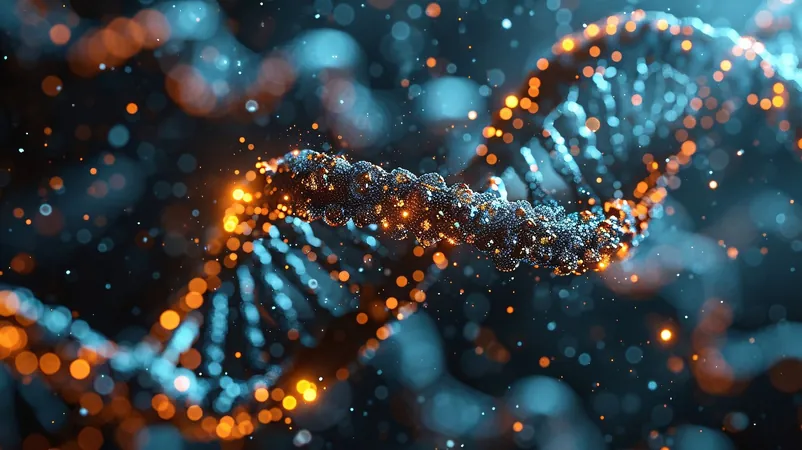
Breakthrough Discovery: The ‘3D Genome Organizer’ That Could Transform Fertility and Cancer Treatment!
2025-08-25
Author: Jacques
A Revolutionary Find in Genetics!
Researchers at Kyoto University have unveiled a groundbreaking discovery: a new mitotic cohesin complex known as STAG3-cohesin, which plays a pivotal role in shaping the unique DNA architecture of spermatogonial stem cells (SSCs)—the very cells responsible for sperm production. This 'DNA organizer' is not just fascinating; it’s absolutely essential for fertility in mice. Without STAG3, these vital cells struggle to develop properly, leading to significant fertility issues.
Implications for Humans: Fertility and Cancer Insights!
In humans, the significance of STAG3 takes a dramatic turn. The research indicates that STAG3 is highly active in immune B cells and B-cell lymphomas, a type of blood cancer. Strikingly, when STAG3 was inhibited, the growth of these lymphoma cells slowed down, suggesting potential avenues for innovative treatment options aimed at both infertility and certain cancers.
The DNA Puzzle: How It All Fits Together!
To visualize this, imagine our DNA as a long string—in every cell, this string is meticulously folded and organized within a nucleus smaller than a human hair. This intricate packaging relies on special proteins called cohesins, which were previously understood to exist mostly in two forms. However, the discovery of STAG3-cohesin unveils a previously unrecognized type that's tailored for germ cell function.
Mapping the Mystery: The Role of STAG3-Cohesin!
During their study, scientists meticulously mapped the presence of various cohesin proteins in SSCs, unraveling STAG3's unexpected partnership with RAD21. This novel combination not only highlights a new form of cohesin but also plays a fundamental role in maintaining weak DNA boundaries crucial for SSC development.
Fertility Crisis: The Consequences of STAG3 Lack!
The researchers created genetically modified SSCs: one set devoid of STAG3 and another exclusively featuring STAG3. The fallout was startling—mice missing STAG3 struggled to transition from stem-cell status to advanced sperm development, cementing the protein's vital importance in gamete formation.
STAG3's Double Life: From Germ Cells to Cancer!
The plot thickens as researchers extended their investigation into other human cell types, revealing STAG3’s high expression in immune B cells. The implications? Blocking STAG3 in lab settings drastically slowed the proliferation of B-cell lymphoma cells, highlighting a potential target for groundbreaking cancer therapies.
A New Era in Genetic Research!
This study not only presents STAG3-cohesin as a novel type of DNA-organizing complex but also hints at transformative implications for areas like stem cell biology, reproductive medicine, and oncology. With the ability to manipulate STAG3 levels and observe direct changes in stem cell ratios in testes, researchers may have stumbled upon a new regulatory mechanism at the intersection of normal cell division and the onset of meiosis.
The Future of Medicine: Hope on the Horizon!
Led by notable figures such as Prof. Mitinori Saitou, Dr. Masahiro Nagano, and Dr. Bo Hu, this pioneering research promises to reshape our understanding of how gene activity is controlled and could unlock new treatment pathways for infertility and cancer. As further investigation unfolds, the medical world watches with bated breath for what these findings could mean for the future!









 Brasil (PT)
Brasil (PT)
 Canada (EN)
Canada (EN)
 Chile (ES)
Chile (ES)
 Česko (CS)
Česko (CS)
 대한민국 (KO)
대한민국 (KO)
 España (ES)
España (ES)
 France (FR)
France (FR)
 Hong Kong (EN)
Hong Kong (EN)
 Italia (IT)
Italia (IT)
 日本 (JA)
日本 (JA)
 Magyarország (HU)
Magyarország (HU)
 Norge (NO)
Norge (NO)
 Polska (PL)
Polska (PL)
 Schweiz (DE)
Schweiz (DE)
 Singapore (EN)
Singapore (EN)
 Sverige (SV)
Sverige (SV)
 Suomi (FI)
Suomi (FI)
 Türkiye (TR)
Türkiye (TR)
 الإمارات العربية المتحدة (AR)
الإمارات العربية المتحدة (AR)